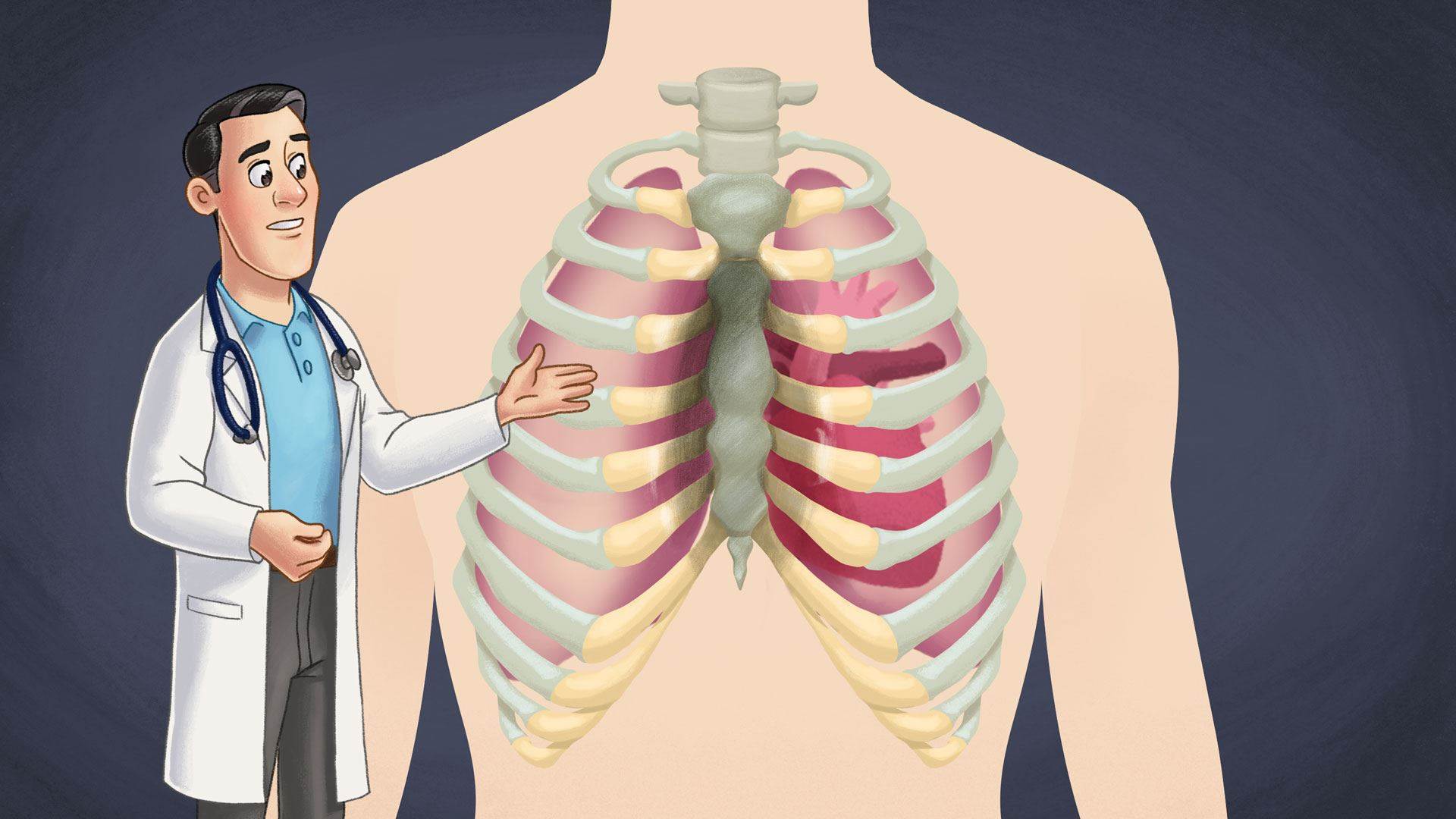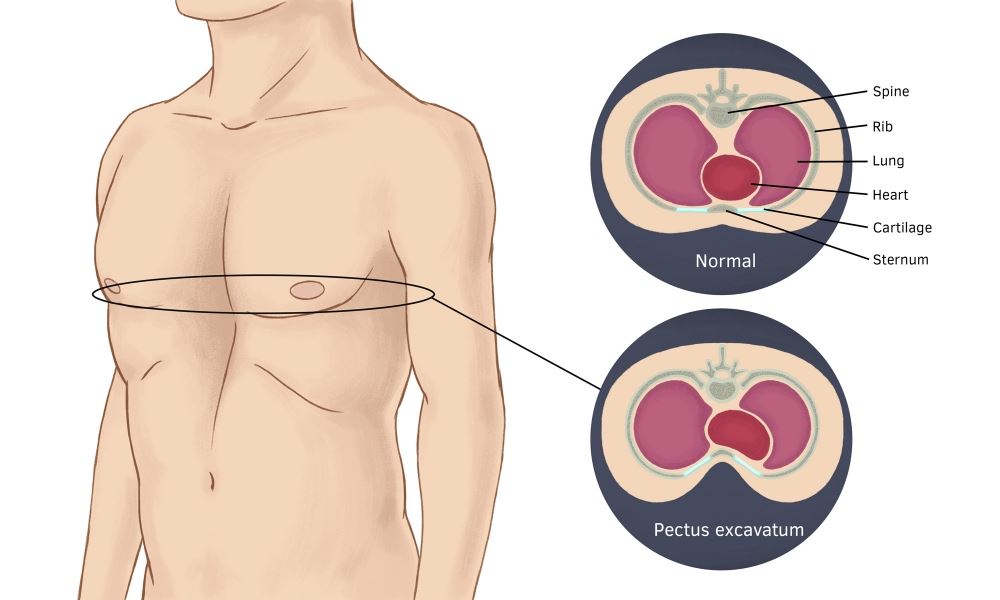Cleft lip and palate are congenital conditions in which the two sides of a baby’s top lip or roof of the mouth do not join up during foetal development. Surgery is normally performed to correct the condition, usually between the ages of six months and two years.…

Pectus excavatum
What is pectus excavatum?
Pectus excavatum, also known as 'funnel chest', 'sunken chest' or 'Cobbler's chest', is a congenital chest wall deformity. It is the most common chest abnormality present at birth, appearing in about one in every 300-500 live births. In a person with pectus excavatum, the middle of the chest appears sunken.
Mild pectus excavatum usually does not have any further effects on the body. However, the abnormal appearance it gives the chest can cause body image issues for the person. In severe cases of pectus excavatum, where the sunken area is deep, the lungs and the heart may be affected.
 In a person with pectus excavatum, the middle of the chest appears sunken as a result of excessive connective tissue connecting the ribs to the sternum.
In a person with pectus excavatum, the middle of the chest appears sunken as a result of excessive connective tissue connecting the ribs to the sternum.
Congenital
Present from birth.
Connective tissue
A category of body tissue that connects and supports other body tissues.
Heart
The muscular organ in the chest that pumps blood through the body by rhythmic contraction and dilation.
Lungs
The pair of organs in the chest responsible for breathing.
Sternum
The flattened bone in the middle part of the chest that connects with the collarbones and some of the ribs. Also known as the breastbone.
Koumbourlis, A.C. (2009) Pectus excavatum: pathophysiology and clinical characteristics. Paediatric Respiratory Reviews 10:3–6.
Dean, C., Etienne, D., Hindson, D., et al. (2012) Pectus excavatum (funnel chest): a historical and current prospective. Surgical and Radiologic Anatomy 34:573–579.
Robert S. Eisinger Journal of Surgical Research March (2019) Pages 93-97.
External linkCauses and risk factors
It is not known what causes pectus excavatum. It is due to abnormal growth of cartilage connecting the breastbone and the ribs. Pectus excavatum is about four times more common in boys than in girls. Of all people with pectus excavatum, 15-40% have a close relative with the condition, suggesting it has some genetic basis.
Pectus excavatum is associated with numerous syndromes, mainly involving bone, muscle and connective tissue, including:
- Marfan syndrome - a genetic disorder of connective tissue. Pectus excavatum is a symptom of Marfan's syndrome;
- Noonan syndrome - a genetic condition that typically affects the heart, musculoskeletal system, facial features, kidneys, spleen and liver;
- Poland syndrome - a disorder affecting chest muscles;
- Ehlers-Danlos syndrome - a group of genetic disorders affecting the collagen protein in connective tissues, causing hypermobile joints and fragile, easily-stretched skin;
- Osteogenesis imperfecta - a genetic disorder that causes bones to be brittle and easily breakable;
- Scoliosis - an abnormally curved spine;
- Spinal muscular atrophy - a genetic disorder of spinal nerve cells that affects muscle control;
- Congenital heart disease;
- King-Denborough syndrome - a rare genetic disorder affecting the muscles and facial features, and;
- Sprengel's deformity - a problem with the shoulder blade due to a scapula bone that is too high.
In addition, pectus excavatum is associated with asthma and a higher risk of respiratory infections.
Cartilage
A tough, flexible connective tissue found in various parts of the body including the joints and larynx.
Collagen
A protein that is the main component of various connective tissues.
Congenital
Present from birth.
Connective tissue
A category of body tissue that connects and supports other body tissues.
Genetic
Related to genes, the body's units of inheritance or origin.
Heart
The muscular organ in the chest that pumps blood through the body by rhythmic contraction and dilation.
Infections
Entry into the body of microorganisms that can reproduce and cause disease.
Kidneys
A pair of organs responsible primarily for regulating the water balance in the body and filtering the blood.
Liver
A large, internal organ of the body, located on the upper right-hand side of the abdomen. The liver has hundreds of distinct functions, including producing bile, regulating the body's metabolism and detoxifying the blood.
Marfan syndrome
A genetic disorder that affects the body's connective tissue. This condition can affect many different parts of the body, but commonly affects the heart, blood vessels, bones, joints and eyes.
Muscle
A type of soft tissue capable of contracting and relaxing to produce force and motion in the body.
Musculoskeletal
The organ system that gives humans the ability to move using their muscular and skeletal systems. It is made up of the bones of the skeleton, muscles, cartilage, tendons, ligaments, joints and connective tissue.
Spleen
An organ in the abdominal cavity that is involved in filtering out old blood cells and fighting infection.
Respiratory
Relating to respiration, the process of inhaling and exhaling air.
Osteogenesis imperfecta
An inherited condition characterised by extremely brittle bones that fracture easily.
Noonan syndrome
An inherited condition that causes heart disease that is present from birth, short stature and delayed development.
Poland syndrome
A condition that results in underdeveloped chest muscles, usually on the right side of the chest wall.
Congenital heart disease
Any heart abnormality that is present from birth, such as a narrowing of the vessels or holes in the heart chambers.
Koumbourlis, A.C. (2009) Pectus excavatum: pathophysiology and clinical characteristics. Paediatric Respiratory Reviews 10:3–6.
Dean, C., Etienne, D., Hindson, D., et al. (2012) Pectus excavatum (funnel chest): a historical and current prospective. Surgical and Radiologic Anatomy 34:573–579.
Kotzot, D. and Schwabegger, A.H. (2009) Etiology of chest wall deformities—a genetic review for the treating physician. Journal of Pediatric Surgery 44:2004–2011.
Aloi, I., Braguglia, A. & Inserra, A. (2009). Pectus excavatum. Paediatrics and Child Health 19, Supplement 2: S132–S142.
Fonkalsrud, E.W., Dunn, J.C.Y. and Atkinson, J.B. (2000) Repair of pectus excavatum deformities: 30 years of experience with 375 patients. Annals of Surgery 231:443–448.
Fonkalsrud, E.W., Dunn, J.C.Y. and Atkinson, J.B. (2000) Repair of pectus excavatum deformities: 30 years of experience with 375 patients. Annals of Surgery 231:443–448.
Signs and symptoms
Many people with pectus excavatum have no symptoms and lead a normal life. Symptoms of pectus excavatum can include:
Physical signs
- A sunken area in the middle of the chest, which is present at birth, but may not be recognised until an older age;
- A displaced breastbone (sternum), usually to the right;
- Scoliosis - an abnormal curvature of the spine;
- Chest pain, and;
- A characteristic slouching posture.
Physiological signs
- In more severe cases, pain and difficulty with physical exertion and exercise, since the lungs and the heart cannot expand normally, and;
- Irregularities in heartbeat (arrhythmias and heart palpitations).
Psychological signs
- Some older children and adults can be bothered by the appearance of their chests, which may affect their body image and lead them to be embarrassed with their appearance.
Heart
The muscular organ in the chest that pumps blood through the body by rhythmic contraction and dilation.
Lungs
The pair of organs in the chest responsible for breathing.
Sternum
The flattened bone in the middle part of the chest that connects with the collarbones and some of the ribs. Also known as the breastbone.
Brochhausen, C., Turial, S., Muller, F.K.P., et al. (2012. Pectus excavatum: history, hypotheses and treatment options. Interactive Cardiovascular and Thoracic Surgery 14:801–806.
Methods for diagnosis
Pectus excavatum is diagnosed by the appearance of the chest. Further tests can evaluate how each person with pectus excavatum is affected by the condition, if at all. These tests can include:
- Lung function and lung capacity tests (such as spirometry);
- A computerised tomography (CT) scan of the chest;
- Electrocardiography (ECG) to rule out heart defects, and;
- Exercise testing to evaluate the function of the heart and lungs during exercise.
Computerised tomography
A scan that uses X-rays to create a 3D image of the body. This can detect abnormalities more effectively than a simple X-ray can.
Heart
The muscular organ in the chest that pumps blood through the body by rhythmic contraction and dilation.
Lungs
The pair of organs in the chest responsible for breathing.
Spirometry
A test used to determine how quickly you take air in, how much air you inhale and how quickly you expel air. It is used to diagnose various lung conditions.
Electrocardiography
A test that uses electrodes placed on the chest and limbs to record the electrical impulses causing the contractions of the heart.
Brochhausen, C., Turial, S., Muller, F.K.P., et al. (2012. Pectus excavatum: history, hypotheses and treatment options. Interactive Cardiovascular and Thoracic Surgery 14:801–806.
Prognosis
In many cases, pectus excavatum will remain as it is. In about a third of people, the condition will become more pronounced during puberty.
Puberty
The period of life, initiated by hormonal signals, in which a person becomes capable of reproduction as the sexual and reproductive organs mature.
Dean, C., Etienne, D., Hindson, D., et al. (2012) Pectus excavatum (funnel chest): a historical and current prospective. Surgical and Radiologic Anatomy 34:573–579.
Types of treatment
Pectus excavatum often does not require treatment at all; many people live completely healthy, normal lives. For those who do need (or want) treatment, there are several options:
Surgery
There are numerous surgical procedures that can repair pectus excavatum. Whether or not to undergo chest 'reconstruction' to repair pectus excavatum depends on the individual case. The timing of surgery is also important; experts currently recommend delaying surgery until after puberty. Nowadays, the Nuss method is preferred over the earlier, more invasive Ravich method, especially for children. It involves inserting a curved metal bar into the chest to remove the central sunken area in the chest.
Vacuum bell
The 'vacuum bell' is a recent non-surgical treatment method. It involves attaching a large bell-shaped suction cup to the chest and using vacuum to lift the sternum. Repeated treatments show an improvement in pectus excavatum symptoms, but it is not yet clear what the long-term benefits may be.
Puberty
The period of life, initiated by hormonal signals, in which a person becomes capable of reproduction as the sexual and reproductive organs mature.
Sternum
The flattened bone in the middle part of the chest that connects with the collarbones and some of the ribs. Also known as the breastbone.
Dean, C., Etienne, D., Hindson, D., et al. (2012) Pectus excavatum (funnel chest): a historical and current prospective. Surgical and Radiologic Anatomy 34:573–579.
Aloi, I., Braguglia, A. & Inserra, A. (2009). Pectus excavatum. Paediatrics and Child Health 19, Supplement 2: S132–S142.
William Rainey Johnson, D.F. (2014). Systematic review of surgical treatment techniques for adult and pediatric patients with pectus excavatum. Journal of cardiothoracic surgery 9:25.
Aloi, I., Braguglia, A. & Inserra, A. (2009). Pectus excavatum. Paediatrics and Child Health 19, Supplement 2: S132–S142.
Haecker, F.-M. (2011) The vacuum bell for conservative treatment of pectus excavatum: the Basle experience. Pediatric Surgery International 27:623–627.






